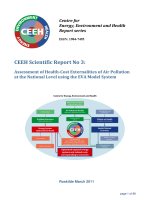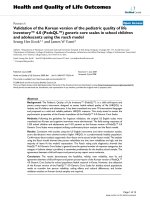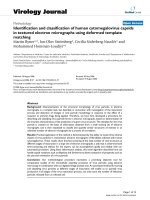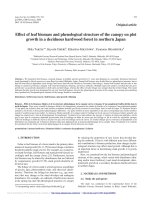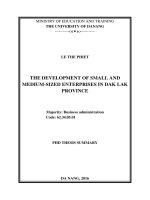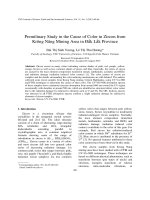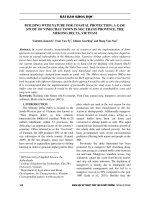Forecasting soil carbon stock of deciduous broadleaf forest in Dak Lak province using the RothC model
Bạn đang xem bản rút gọn của tài liệu. Xem và tải ngay bản đầy đủ của tài liệu tại đây (1.12 MB, 9 trang )
Science on Natural Resources and Environment 43 (2022) 70-79
Science on Natural Resources and Environment
Journal homepage: tapchikhtnmt.hunre.edu.vn
FORECASTING SOIL CARBON STOCK OF DECIDUOUS
BROADLEAF FOREST IN DAK LAK PROVINCE USING
THE ROTHC MODEL
Duong Dang Khoi
Hanoi University of Natural Resources and Environment, Vietnam
Received 04 October 2022; Accepted 28 November 2022
Abstract
This study aims to apply the RothC model for predicting the carbon storage
potential of Deciduous Broadleaf Forest (DBF) in Dak Lak province. The prediction
results reveal that soil organic carbon of the DBF shows an increasing trend during
the period of 2020 - 2050. The results of the prediction of organic components indicate
that Humi�ed Organic Mater (HUM) and Resistant Plant Material (RPM) are the main
components of total soil organic matter in the DBF region. Decomposable Plant Material
(DPM), Microbial Biomass (BIO), and Inert Organic Matter (IOM) account for smaller
percentages. The di erent states of the DBF are projected to have approximately the
same soil carbon storage levels. Speci�cally, the moderate DBF is predicted to store a
soil organic amount of 70.42 tons per hectare. The poor DBF is forecasted to have an
average organic amount of 70.37 tons per hectare. The very poor DBF is projected to
store an amount of 72.15 tons per hectare. Forecasting of the DBF soil carbon storage
potential is for the assessment of the total organic carbon stock of the DBF ecosystem,
as a basis for payment of local forest carbon storage service.
Keywords: RothC; Total Organic Carbon (TOC); Soil Organic Carbon (SOC);
Deciduous Broadleaf Forest (DBF); Dak Lak.
Corresponding author. Email:
1. Introduction
Soil organic carbon is an important
carbon pool of forest ecosystems, playing
an important role in storing CO2 in the
soil, and contributing to climate change
mitigation (FAO, 2018; Yao Huang et al.,
2008). However, the prediction studies of
the ability to store organic carbon in forest
soils have not received much attention
in Vietnam. The main reason is limited
funding for forest soil carbon surveys.
70
Moreover, forest soil carbon prediction
using the modeling method has not been
paid attention.
In the literature, various methods
can be applied to estimate the carbon
storage capacity of forest soil, but the
most common methods are soil survey
and modeling. The soil survey is a
standardized method, widely applied,
with the highest accuracy. However, soil
survey often requires a long time and a
large amount of money and manpower
involved in taking soil samples as well
as analyzing soil samples. The modeling
method is often applied to forecast soil
organic matter using existing soil datasets.
The most commonly used models for
quantitative assessment of soil organic
carbon are CENTURY (Parton et al.,
1987), RothC (Coleman and Jenkinson,
1999), Agro-C (Yao Huang et al., 1999).
2008) and InVEST-C (Tallis et al., 2013).
The RothC, developed from
experimental data at the Rothamsted
Agricultural Research Station of the
United Kingdom, often applies to assess
soil organic matter in non - ooded areas.
Currently, the model has been extended
to include agricultural, grass and forest
soil worldwide (Coleman and Jenkinson,
1999; Falloon et al., 1998; Weihermüller
et al., 2013). Datasets required for running
the model include monthly rainfall,
monthly evaporation, monthly average
temperature, clay content and organic
matter decomposition coe cients. In this
study, the RothC is applied to predict the
organic matter storage potential in the
soil of the DBF in Dak Lak province. The
RothC was chosen because the dataset
used to run the model can be collected
locally and is suitable for the limited soil
data conditions of Vietnam and Dak Lak
province.
by the Dak Lak Department of Natural
Resources and Environment (Dak Lak
Department of Natural Resources and
Environment, 2019). In addition, 60 soil
samples were taken at the study area in
the year 2022 to supply the prediction.
2.2. Predicting soil carbon stock by
RothC model
The study predicts soil carbon storage
potential by the RothC for each soil type
within the boundary of the DBF, then
synthesizes the carbon storage potential
according to each forest state type. Soil
carbon stock predicted by RothC software
can be summarized in the following steps:
Step 1. Calculate initial organic
components: initial organic components
starting in the year 2020 (DPM, RPM,
BIO, HUM, IOM) were calculated
using pedotransfer functions (Falloon et
al., 1998; Weihermüller et al., 2013) as
follows:
+ Resistant Plant Material (RPM) is
estimated as:
RPM = (0.1847*SOC+ 0.1555) * (clay+
1.2750)−0.1158
In which, clay is the percentage of
soil mass, SOC is soil organic carbon
(tons per hectare)
+ Decomposable Plant Material
(DPM) is given as:
2. Methods
DPM is estimated by the ratio of
2.1. Data collection
RPM and DPM.
The secondary datasets of monthly
+ Microbial Biomass (BIO) is
rainfall, monthly evaporation, monthly estimated as:
mean temperature, clay content and soil BIO = (0.0140*SOC + 0.0075)*(clay +
organic carbon were collected to run the
8.8473) 0.0567
RothC. Meteorological data was collected
+ Humi ed Organic Matter (HUM)
in the period 1981 - 2018. The clay and
is
calculated
as:
soil organic content dataset were collected
from the soil degradation survey dataset HUM = (0.7148*SOC + 0.5069) * (clay
+ 10.3421) 0.0184
of Dak Lak province in 2019 released
71
+ Inert Organic Matter (IOM ) is
The amount of organic carbon
calculated as:
decomposed in one month is estimated as:
IOM = 0.0049*TOC1.139
Y(1- e-abckt)
In which, TOC is total soil organic
carbon.
Step 2. Create a soil data le: Enter
monthly organic material input data, along
with monthly land cover in le format in
RothC software.
Step 3. Create a climate dataset le:
Enter monthly rainfall data, monthly
evaporation amount, monthly average
temperature, and simulated clay content
and soil thickness data into the format
table of RothC software.
Step 4. Create a scenario.set le for
running the RothC model. The software
allows to create a script le for running
the model, the scenario le will integrate
all input data including input organic
matter and climate data. The le is saved
in the format “scenario.set”.
Step 5. Run RothC according to the
le “senario.net” of each soil type. Run the
“scenario.set” created in step 4 using the run
command. The RothC calculates the amount
of each organic component. Let say Y (ton
C per hectare) is the amount of organic
carbon (Y is the component of DPM, RPM,
BIO, HUM, except for the IOM component
because IOM is very stable, lasts 50,000
years, so it does not calculate uctuations
in time) at a certain time (month), then
after one month the carbon stock of each
component according to the state of the
forest is calculated (Coleman and Jenkinson,
1999) by the expression as:
Ct = Y*e
-abckt
a is the constant of adjustment for the
e�ect of temperature, b is the constant of
adjustment for the e�ect of moisture, c is
the decomposition constant of the organic
component; t = 1/12 because it is month
by month.
a = 47.9/1+e (106/T+18.3)
where T is the monthly average
temperature.
b = - (20.0 + 1.3 (% clay) - 0.01 (%
clay)2)
The value of b is calculated for the
soil layer of 23 cm if the soil thickness is
greater than 23 cm, then b is adjusted as
divided by 23 and multiplied by the soil
thickness (cm).
c = 0.6 for soil with land covered by
vegetation and c = 1.0 for bare land.
k is assigned a constant of 10 for
DPM; 0.3 for RPM, 0.66 for BIO; 0.02
for HUM.
Step 6. Interpret simulation results:
Display the results in the form of graphs
or access the resulting data les for each
soil type to perform analysis and present
the resulting data in appropriate graphs or
charts.
3. Results
3.1. Predicting soil carbon stock by
soil type
By the use of the input datasets
In which, Ct is the amount of the
of
organic
materials, climate and soils
residual carbon component in the soil
at the time after one month from the in the region, RothC predict change in
DPM, RPM, BIO, and HUM components
starting time.
72
for each month in the entire simulation
period. The climate dataset used in the
study is from 1981 to 2018 (37 years).
Therefore, the study makes a forecast for
30 years from 2020 to 2050. The starting
point is de ned at the year 2020.
a. Fluvisols
Fluvisols consist of 2 soil types
distributed in the DBF area; therefore,
the study predicts these soil types. The
red - yellow patchy alluvial soil (Pf) soil
shows an uptrend carbon in the simulation
period.
Figure 1: Change in predicted soil
carbon of Pf
b. Acrisols
The glay soil based on acid magma
and sand rock (Xa) covers an area of
137,473 hectares, accounting for 10.51 %
of the province’s total natural area. Xa is
distributed in most of the Ea Sup, Ea Kar
and Ea HLeo districts. The forecast results
showed that the amount of organic matter
accumulated in the soil has increased
steadily, with a large contribution from the
increase in the amount of RPM, followed
by HUM.
Figure 3: Change in predicted soil
carbon of Xa
c. Luvisols
The stream and alluvial soil (Py)
is formed mainly along narrow, steep
streams with strong currents on relatively
lower terrain compared to other areas
of the region. The forecasting results
showed that there is a decrease in the
amount of organic matter for several years
from the starting year 2020, followed by
a cycle of increasing soil organic matter
accumulation until 2050. This is explained
by an increase in HUM as well as RPM in
the soil.
The black soil based on basalt rock
(Rk and Ru soils) has an area of 8,286
hectares, accounting for 0.55 % of the
province’s natural area. Luvisols are
distributed in lowland terrain, narrow
valleys where there are conditions to
accumulate accretion products of basalt
rock. The simulation results showed that
the total organic matter increased as a
result of an increase in HUM and RPM.
Figure 2: Change in predicted soil
carbon of Py
Figure 4: Change in predicted soil
carbon of Rk
73
The yellow - brown soil based on
ancient alluvium rock (Fq), organic matter
in the rst period is that the amount of
HUM dominates, then RPM prevails in
the later stage.
Figure 5: Change in predicted soil
carbon of Ru
d. Ferrasols
The red - yellow soil based on acid
magmatic rock (Fa), the amount of HUM
Figure 8: Variation in predicted soil
dominates in the calculation period, the
carbon of Fq
HUM is much larger than the RPM, almost
The yellow - red soil based on clay
twice. At the end of 2050, the amount
and metamorphic rocks (Fs) and the
of new RPM increased by oversold
yellow - brown soil based on basalt rock
compared to the amount of HUM.
(Fu), HUM always dominates in the
whole forecast period. The amount of
RPM accounted for less than half (Fs and
Fu) in the late period. Thus, HUM is the
decisive factor in the total organic content
in Fs, Fu soil in the study area.
Figure 6: Change in predicted soil
carbon of Fa
With the red - brown soil based on
basalt rock (Fk), the two components
HUM and RPM are adjusted in the
simulation stages. In the rst 20 years
(2020 - 2040), the amount of humus
(HUM) dominates. But in the period of
2040 - 2050, the amount of HUM and
RPM are approximately the same.
Figure 9: Change in predicted soil
carbon of Fs
Figure 10: Change in predicted soil
carbon of Fu
Figure 7: Change in predicted soil
carbon of Fk
74
e. Humic Ferrasols
The analysis of the organic carbon
predicted by RothC showed that the
amount of HUM is dominant over the
entire forecast period. The amount of
RPM is cumulative and is about half of
the HUM at the end of the forecast period.
Figure 12: Change in predicted soil
carbon of D
Figure 11: Change in predicted soil
carbon of Ho
f. Dystric Gleysols
The valley soil (D) has an area of
11,548 hectares, accounting for 0.83 % of
the total natural area of the province. It
is scatteredly distributed in the valleys of
the hilly areas, present in most districts,
except Ea Sup district. The results showed
that the accumulated organic amount in
the 30 - year period (2020 - 2050) ranges
from 60 to nearly 80 tons per hectare. In the
valley soil, HUM and RPM components
are dominant in the forecasting period, the
remaining organic components account
for a small proportion.
g. Lithic Laptosols
The erosive soil (E) covers an area of
27,538 hectares, accounting for 2.10 % of
the total natural area, mainly concentrated
in Ea Hleo, Ea Sup and Buon Don districts.
If a�orestation and forest restoration
are carried out, the total organic carbon
will increase signi cantly, ranging from
45 to 85 tons per hectare during the
forecast period. The predominant organic
component is HUM in the rst 10 years of
the forecast, and then in the next 20 years,
the RPM dominates.
Figure 13: Change in predicted soil
carbon of E
3.2. Predicting soil carbon stock by forest states
a. Moderate deciduous broadleaf forest
Table 1. Predicted TOC of soil types in moderate deciduous broadleaf forest
75
In the state of the moderate DBF, it
is expected to have a carbon stock mean
of 70.42 tons per hectare. However, the
carbon stock of the moderate DBF state
depends on the carbon content of the
soils occupying the predominant area.
The yellow soil is based on sandy rocks
(Fq), accounting for 63.4 % of the total
moderate DBF area and the yellow red
soil is based on clay and metamorphic
rocks (Fs), occupying 11.95 % of the total
moderate DBF. Thus, these soils dominate
the soil carbon of the moderate DBF.
b. Poor deciduous broadleaf forest
The state of the poor DBF is
forecasted to store an amount of carbon
in the period 2020 - 2050 at an average of
70.37 tons per hectare. Just like the poor
DBF state, two types of soil are yellow
soil based on sandy rocks (Fq) accounting
for 61.2 % of the total area of the poor
DBF and red yellow soil based on clay
and metamorphic rocks (Fs) accounting
for 13.83 % of the total area. Therefore,
these two soils govern the carbon stock of
the poor DBF.
Table 2. Predicted TOC of soil types in poor deciduous broadleaf forest
76
c. Very poor deciduous broadleaf
forest
The very poor DBF is forecasted to
store an amount of carbon in the period
2020 - 2050 at an average of 72.15 tons per
hectare. The yellow soil is based on sandy
rocks (accounting for 49.90 % of the very
poor DBF area), the gray soil is based
on acidic igneous rock and sandstone
(20.36 % of the DBF area), red - yellow
soil is based on clay and metamorphic
rock (14.18 % of very poor DBF area), the
red - yellow soil based on acidic igneous
rock (10.55 % of very poor DBF area) are
soil types that dominate the total organic
storage stock of the very poor DBF.
Table 3. Predicted TOC of soil types in very poor deciduous broadleaf forest
77
4. Conclusion
By the use of the RothC model for
predicting soil carbon of DBF soils in
Dak Lak province, the result revealed
that the RothC model is quite suitable in
the condition of Dak Lak province. The
model is a simple, e�ective and cost e�ective calculation tool for the prediction
of organic carbon change over time in
forest soils. The results of predicting
organic components of soils distributed in
the DBF area demonstrated that the total
organic carbon of all soil types shows an
increasing trend in the period 2020 - 2050.
The results of the prediction of changes
in organic components also indicated that
HUM and RPM are the main components
constituting the total organic matter of
the soil. DPM, BIO and IOM account for
smaller percentages. The DBF states are
projected to have approximately the same
soil organic carbon storage levels. The
moderate DBF state has a soil organic
stock mean of 70.42 tons per hectare. The
poor DBF is forecasted to have an organic
stock mean of 70.37 tons per hectare. The
very poor DBF is forecasted to have a
storage capacity mean of 72.15 tons per
hectare. The prediction results can be used
as useful reference data for estimating
the economic value of soil carbon in the
local DBF, as a basis for payment of DBF
carbon storage service.
Acknowledgements: This study
was funded by the Dak Lak Department
of Science and Technology through the
research project: “Quanti�cation of CO2
storage capability of forest states and
rubber plantation in Dak Lak province
using Landsat data” with grant number
97/HD-SKHCN. The author would
like to thank the anonymous reviewer
for constructive comments that help to
improve the manuscript.
78
REFERENCES
[1]. Department of Natural Resources
and Environment of Dak Lak province
(2019). Report on land degradation in Dak
Lak province in 2019. Department of Natural
Resources and Environment of Dak Lak
province (In Vietnamese).
[2]. FAO (2018). Global soil organic
carbon map: Technical report. FAO, Rome.
[3]. Falloon, P., Smith, P., Coleman, K.
& Marshall, S., (1998). Estimating the size
of the inert organic matter pool from total
soil organic carbon content for use in the
Rothamsted carbon model. Soil Biology and
Biochemistry 30, 1207 - 1211.
[4]. Parton, W.J., Schimel, D.S., Cole,
C.V. & Ojima, D. S. (1987). Analysis of
factors controlling soil organic levels of
grasslands in the Great Plains. Soil Sci. Soc.
Am. J. 51:1173 - 1179.
[5]. Tallis, H. T., Ricketts, T., Guerry,
A. D., Wood, S. A., Sharp, R., Nelson,
E., Ennaanay, D., Wolny, S., Olwero, N.,
Vigerstol, K., Pennington, D., Mendoza, G.,
Aukema, J., Foster, J., Forrest, J., Cameron,
D., Arkema, K., Lonsdorf, E., Kennedy,
C., Verutes, G., Kim, C. K., Guannel, G.,
Papenfus, M., Toft, J., Marsik, M., Bernhardt,
J and Gri n, R., Glowinski, K., Chaumont,
N., Perelman, A., Lacayo, M. (2013). InVEST
2.5.6 User’s Guide. The Natural Capital
Project, Stanford University, USA.
[6]. Huang, Y; Yu, Y; Zhang, W; Sun,W;
Liu, S; Jiang, J; Wu, J; Yu, W; Wang, Y;
Yang, Z. (2006). Agro-C: A biogeophysical
model for simulating the carbon budget of
agroecosystems. Agricultural and Forest
Meteorology 149: 106 - 129.
[7]. Weihermüller, L., Graf, A.,
Herbst, M., Vereecken, H. (2013). Simple
pedotransfer functions to initialize reactive
carbon pools of the RothC model. European
Journal of Soil Science 64: 567 - 575.
